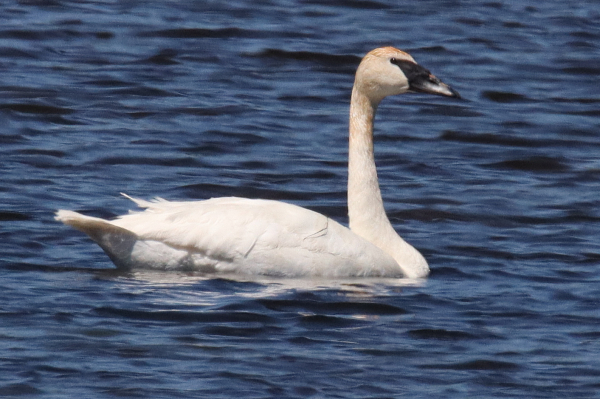
A rare sighting of a pair of Trumpeter Swans was a highlight early Saturday.
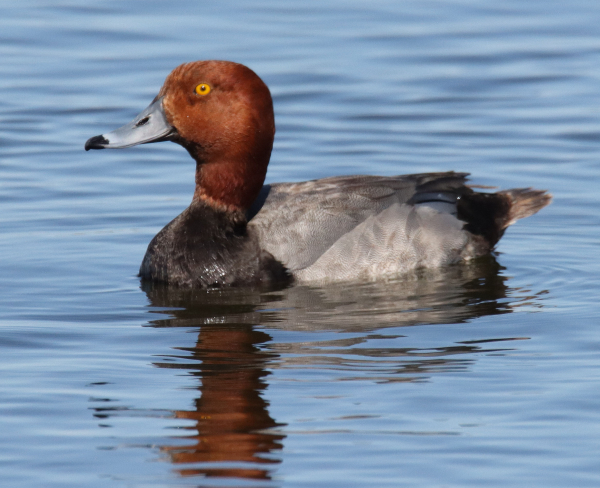
Redheads seem to be more obvious now as pairs remain together in advance of the females’ late nesting season.
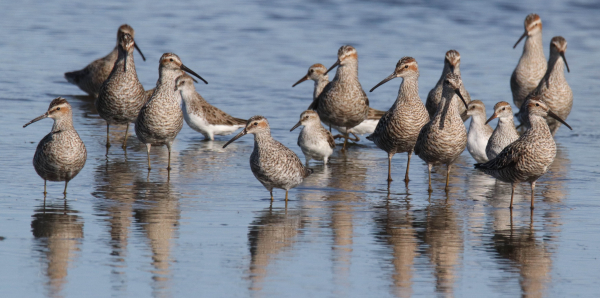
After landing as a flock, Stilt Sandpipers were joined by a couple White-rumped and Semipalmated Sandpipers.
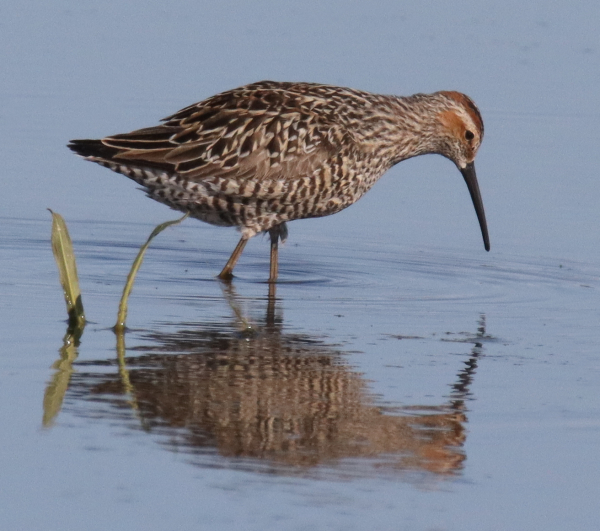
A closer look at a Stilt Sandpiper foraging in the shallows during a State Line stopover on its route to an Arctic nesting site.
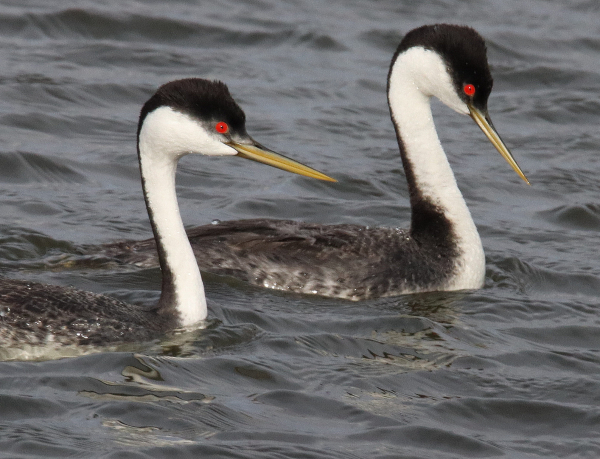
Western Grebes are active in many areas, but few can be found in areas closer to home where they have been common during recent years – an example of annual fluctuations in local distribution.
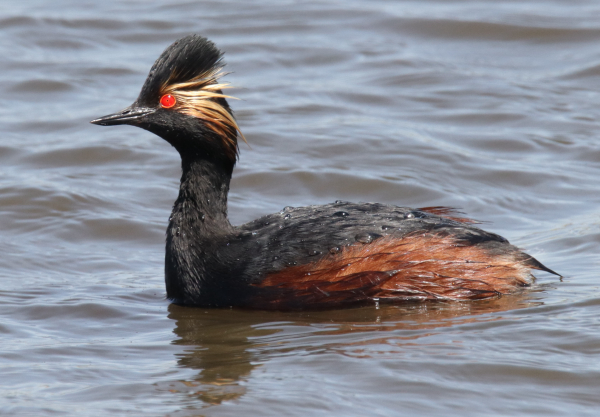
Eared Grebes are not as behaviorally active as Westerns, but they occasionally provide interesting photo opportunities.
|
Just as I was about to finish the article I was writing early Saturday afternoon, my phone broke the silence with my friend Wendell alerting me that he was watching 2 swans swimming on a marsh northwest of his farmstead. In response I said, “When Wendell calls, I drop everything and come running,” and I did! I told him Tundra Swans migrated through the area weeks ago and should be arriving in Arctic tundra ponds to begin nesting by now; but they could be young swans, or they could be Trumpeter Swans, which are very rare west of Minnesota. I drove the 8 miles north, turned and ambled a half-mile down on a dirt road, and there they were – a beautiful pair of Trumpeter Swans, on June 1st!
It was a thrill to see the big swans, and although they were more than halfway across the marsh, the light was nice for a few documentary photographs. The swans were immediately aware of my small white car, but they soon swam to another area of the marsh and began reaching their long necks into the water, feeding on submerged plants. Wendell mentioned they had been on hand for about 4 days, and they seemed pretty settled in, so I hoped for more observations and photo opportunities, and left the swans in a beautiful setting of the blue lake surrounded by the greenest native prairie we get in southeast North Dakota.
As I passed by the farmstead I saw Wendell was loading some organic soybean seeds into a grain hopper to transport to a field his brother Ken was planting near the trumpeter marsh, so stopped to let him know the swans were indeed a pair of Trumpeter Swans, the largest of the world’s 7 species of swans. I shared that they were probably a young pair, looking for a territory or just roaming, and in the process they could possibly extend the species’ nesting range westward.
A friend and associate of mine, Carrol Henderson, led the effort to re-introduce Trumpeter Swans into neighboring Minnesota, which has been an especially successful effort, and the ever-expanding population established there has pushed east, west, and south from original reintroduction areas. I checked back on the Trumpeter pair at the beginning of an extended birding drive about 90 minutes later, and found the swans were loafing on the grass along an open area on the far side of the marsh in the company of a similarly resting group of 4 drake Mallards.
The State Line Wetlands & Hecla Marsh
My birding drive would take me about 70 miles southaest to the James River Valley to check 2 summer hotspots. Along the way, there were many Redheads, Blue-winged Teal, Gadwalls, and Mallards, including the first Mallard brood I’ve observed in the region, complete with an attending hen and a drake. There were also Cattle Egrets in a couple locations, but at the State Line wetlands, shorebirds took center stage, dominated by more than a hundred Semipalmated Sandpipers mixed with a similar number of White-rumped Sandpipers, plus about 40 Stilt Sandpipers, a lone Dunlin, a Lesser Yellowlegs, an American Avocet, and a Willet. There were also scattered White-faced Ibis, a few widely scattered Great Blue Herons, a Cattle Egret that provided a photo op, and a Sedge Wren that didn’t permit a photo.
A few miles across the border into South Dakota, Hecla Marsh provided a different mix of birds for the most part, including many pairs of Western Grebes and Eared Grebes, a nesting Pied-billed Grebe, and many American Coots including the first newly hatched brood of 2. Great Egrets, Snowy Egrets, Great Blue Herons, White-faced Ibis, Double-crested Cormorants, Ruddy Ducks, and the afore-mentioned ducks were also on hand, plus another Mallard brood.
Yellow-headed and Red-winged Blackbirds were common throughout my drive, as were Black Terns; but there was not a raptor in sight during the entire trip – they are around, but weren’t active in spite of the tranquil wind. The following day however, I retraced the first half of my Saturday drive (about 35 miles east) and observed 2 separate male Northern Harriers, 2 lone Turkey Vultures, and an adult Bald Eagle. Even so, Swainson’s Hawks have certainly been secretive lately, even though they are associated with active nesting territories and nests in the area – hmm.
As for the promising pair of Trumpeter Swans, I checked back on them twice Sunday to find them absent from the marsh they graced the day before. Monday I even expanded my search for the giant swans, but there are so many out of sight wetlands in the area and these birds have wings and an ability to fly long distances at a moment’s notice, so they may be continuing a reconnaissance tour, but it was sure exciting knowing they were in the area for a while – a first!
Neotropical Migration Roundup
Similar to last year, I had high hopes for a big songbird migration crescendo that kinda fizzled out after Saturday May 25th. A few Yellow Warblers, Warbling Vireos and Red-eyed Vireos, Gray Catbirds, Brown Thrashers, and Orchard Orioles continued for a couple more days, but by the 28th a grand finale was officially past due. Of course, I continued to do twice daily migration checks at Melody’s Grove, but it was over, and while there wasn’t the volume of songbirds I see some years, there was a very impressive list of rarely seen species.
Living on the far western edge of the migration routes for most “eastern songbirds,” I don’t see the big numbers, or the variety of many places even 100 miles to the east, but I have 3 good fallout locations to check, and it’s a thrill day to day to see what shows up. This year, Melody’s Grove provided the only real songbird stopover action, which was convenient considering it’s only a couple hundred yards from home, and when birds like Mourning Warblers, a Magnolia Warbler, and even rarer species pop into view, there are few greater thrills during May birding moments.
Among my rare sightings for this May, I had a first ever Black-headed Grosbeak that actually returned to my jelly feeder several times during a stopover on May 16th. And there were a few personal “second state records” in the form of a Connecticut Warbler, a Yellow-throated Vireo, a Great Crested Flycatcher, and a Bay-breasted Warbler, which doubled as the first female Bay-breasted – all sighted at Melody’s Grove. There was also my second state record Black-bellied Plover that I was thrilled to photograph at Long Lake Refuge. On another level, I had the first male Rose-breasted Grosbeak feed at my feeding station, attracted by grape jelly, as were 2 females on separate days (although I’ve had a few female grosbeaks feeding on shelled sunflower seeds before). Overall, it was a great songbird migration that included many opportunities to photograph the small, quick, exciting migrants. Can’t wait for next May!
Oriole Action
Actually, the migration has continued into June in my yard, where Orchard Orioles and Baltimore Orioles have really been active, fueled by grape jelly at my feeding station, but also foraging for invertebrates in my trees. It’s only been this week, most notably Monday, when oriole numbers seem to have dropped to 8 or so total. That’s expected as some birds continue migration, and that’s been the rule for most of the feeder orioles up to this point – they come and go with the wind. Now it seems we might be getting down to the orioles that may become local nesters, and that’s exciting too.
I have no doubt that I shortstop a number of orioles each summer, now that I offer grape jelly at my feeding station – on average I’d say 2 Baltimore pairs and 2 Orchard pairs stay to nest. Before keeping a jelly feeder stocked, there were no Baltimore Orioles nesting in the area, although there were scattered Orchard Orioles nesting in thickets in open prairie areas a fair distance to the south. Hoooray for grape jelly is all I can say! Having orioles on hand from May to late August or early September is a huge summer bonus that enriches my home and office periods during daylight hours.
An added result of providing jelly at my feeding station was that Sunday morning one of the robin pairs brought 2 fledglings that could fly pretty well to my feeding station. The young robins haven’t fed directly at the feeders yet, but it’s sure fun to see them in my yard! Other yard sightings included a Thursday flock of Cedar Waxwings that flew in to forage at the top of my ash trees, and a Red-eyed Vireo searched for insects among the new leaves low in the ash tree adjacent to my feeding station. A Western Kingbird flew in to perch outside my bay windows with a newly caught winged insect; kingbirds usually don’t perch that low, but this year it has been happening every once in a while. And while I have heard House Wren songs, I finally saw one next to my house Tuesday afternoon.
And then there are the hummingbirds … Again, I’m located at the far western edge of the range of Ruby-throated Hummingbirds, but although I observed 2 separate female hummingbirds at Melody’s Grove for a few moments about a week apart during migration, they have avoided my yard and feeding station it seems. With the best laid plans, including fresh nectar in my high-perch hummingbird feeder, I even added an extra-large, extra-red hanging petunia next to my feeding station, but I’m still waiting for the first hummingbird to stop by – maybe in late July after nesting – ha – or maybe tomorrow.
Drift Plain Bingo
Monday was a gorgeous day that inspired me to do an extended regional birding drive a bit farther southeast than my usual route, into the edge of the Drift Plain geologic area, a flatter more agricultural region, where I checked on territorial Red-headed Woodpeckers and the nearest Bald Eagle nest. I only managed to see 1 Red-headed Woodpecker, but the eagle nest looked very promising with an adult and at least 1 nestling on the nest. I initially saw the adult eagles at the nest site earlier this spring, but this was my first verification of a nestling, and there could be 1 or 2 more present.
There were many lone male ducks scattered on area marshes, indicating the nesting season was in full force for many species, and I saw groups of 3 and 4 drake Mallards hanging out together, a sign they may begin molting soon. I also saw the first Mallard brood of the season along my regular birding drive, with 4 ducklings about a week old following a female. There are still many pairs intact too, including the later nesting species such as Blue-winged Teal, Gadwalls, Redheads, and Ruddy Ducks. A Bobolink did a flight display before me in the midst of a favorite prairie area, and Upland Sandpipers and Marbled Godwits were active in the ultra-green grasslands too. And for the first time in weeks I also saw one of the pairs of Red-necked Grebes I photographed at Herb’s Lake, swimming and occasionally diving far from shore, but they were easier to see on the glass-like water of the windless morning.
It's a beautiful time of year in my neck of the prairie, where it’s as green as it gets here, and I hope you are enjoying this first week of June with birds and bird songs enlivening your days and brightening your spirits. That’s what birds do, especially during this period, and I hope you enjoy ample time in nature, in the great outdoors, binoculars and camera in hand – Enjoy!
Article and photos by Paul Konrad
Share your bird sightings and photographs at editorstbw2@gmail.com